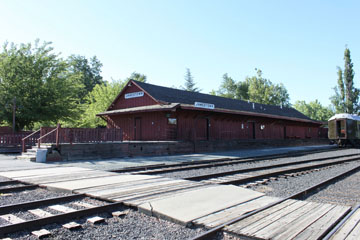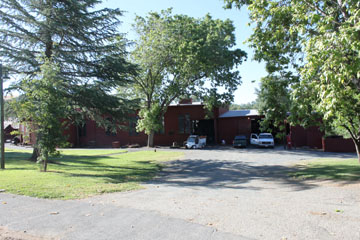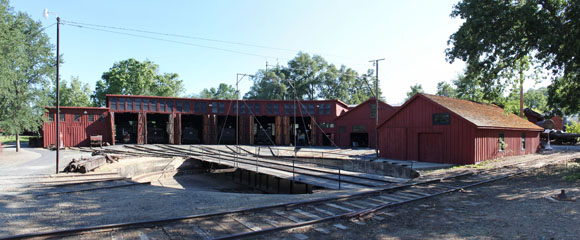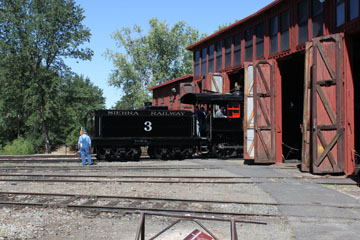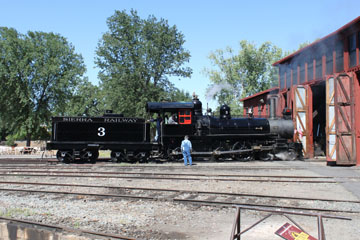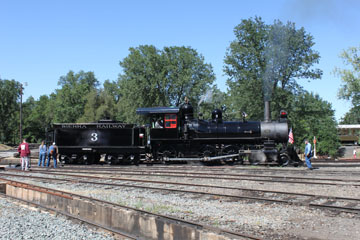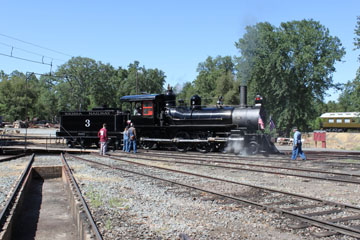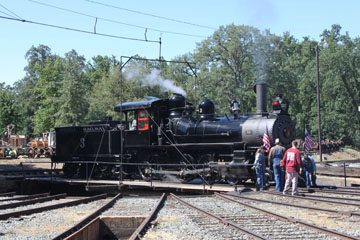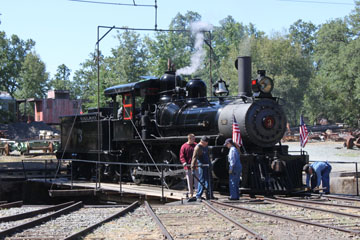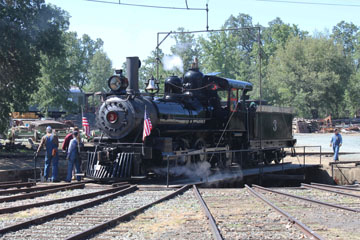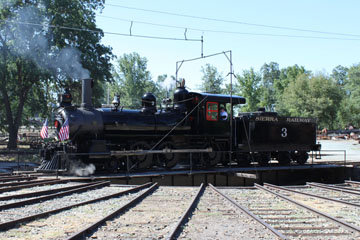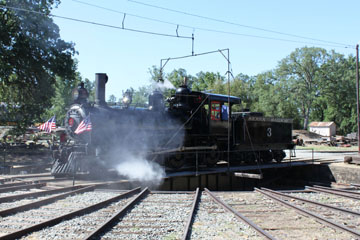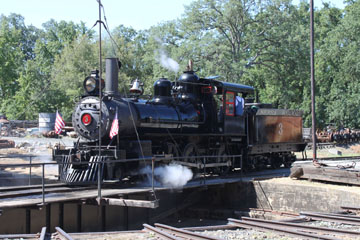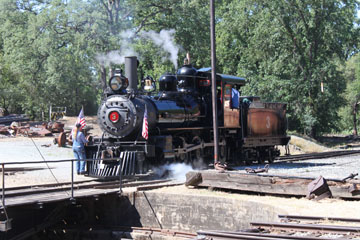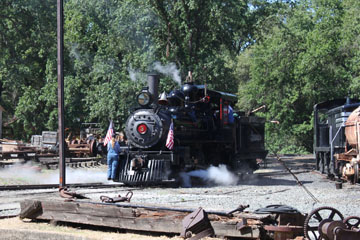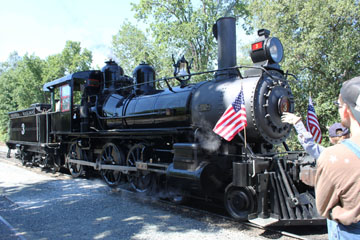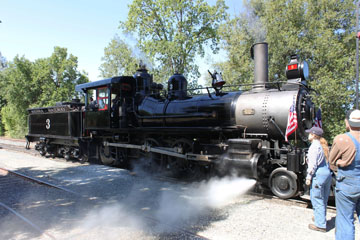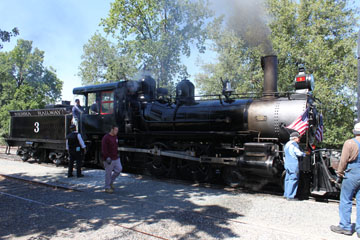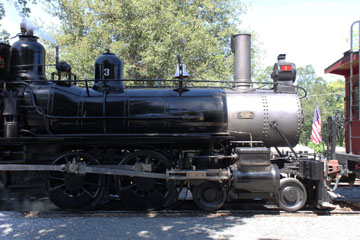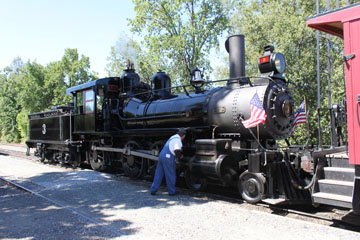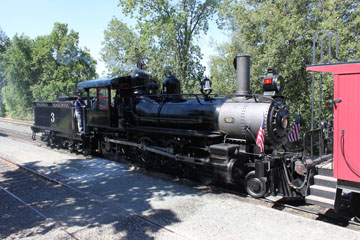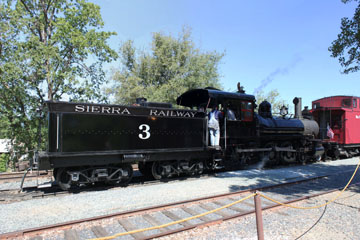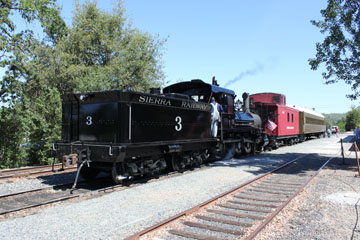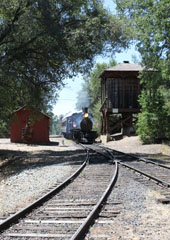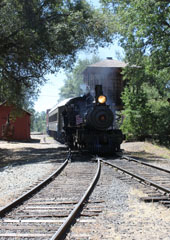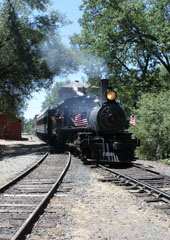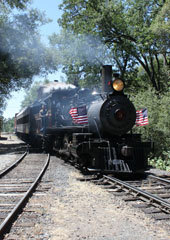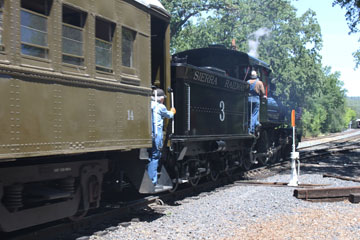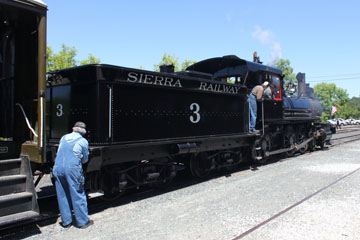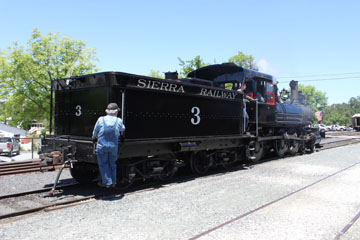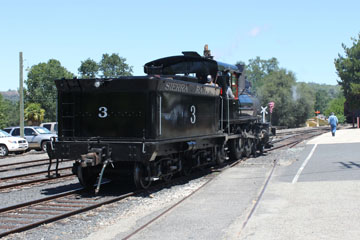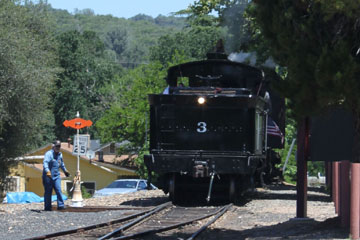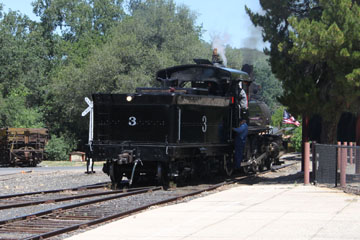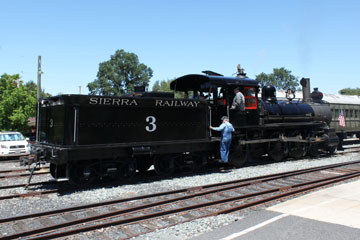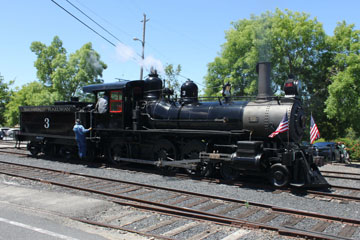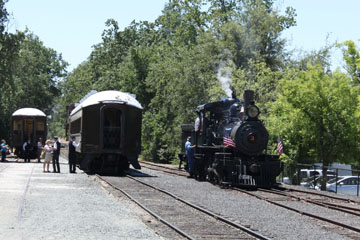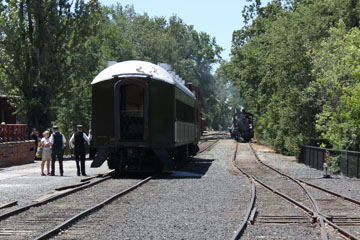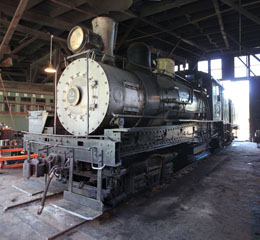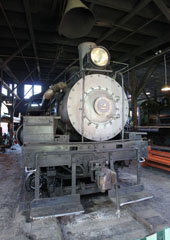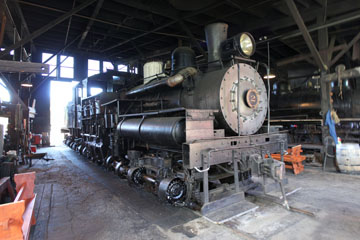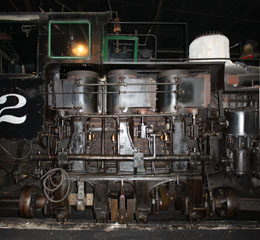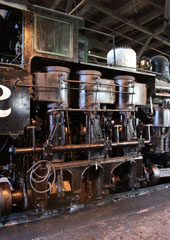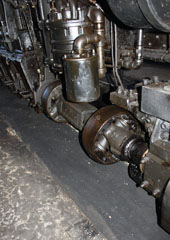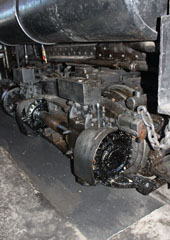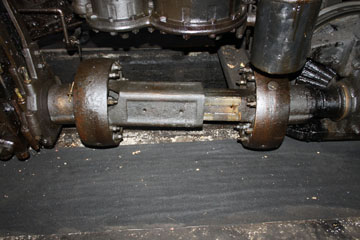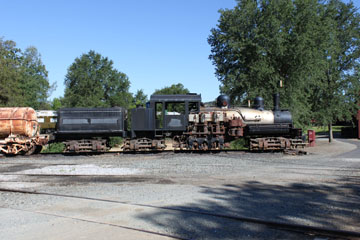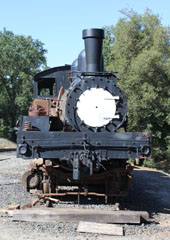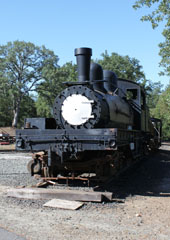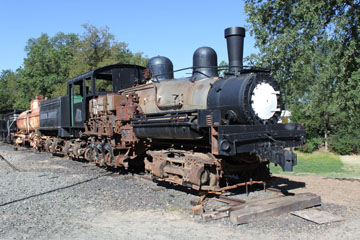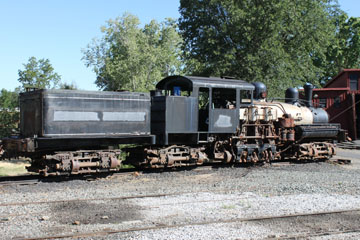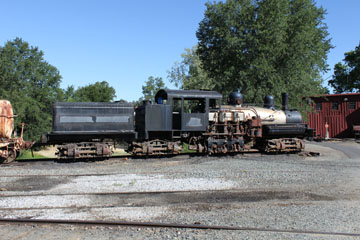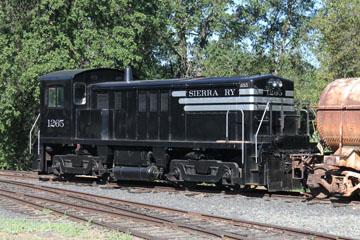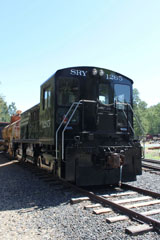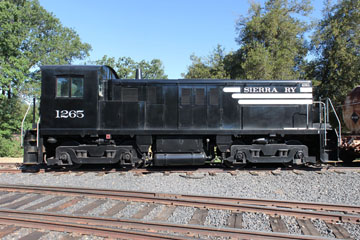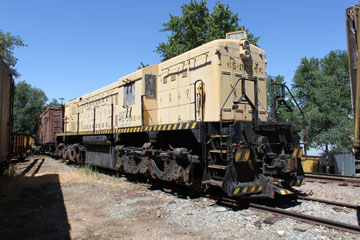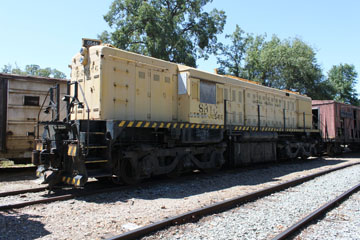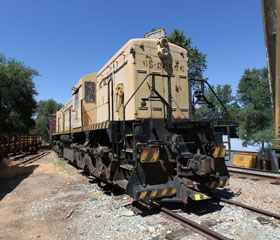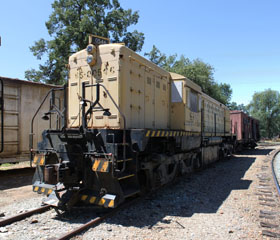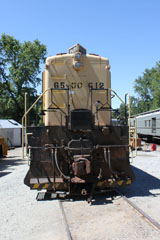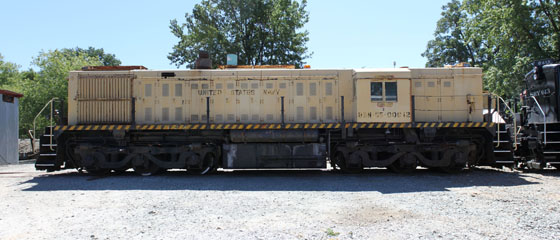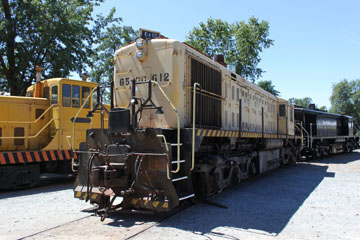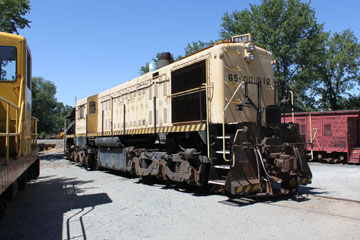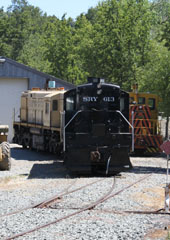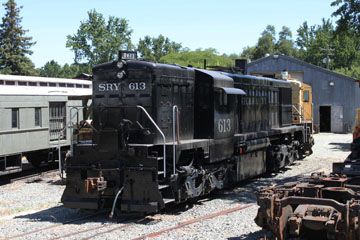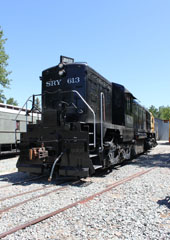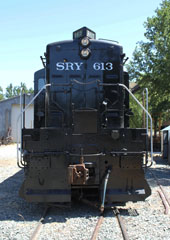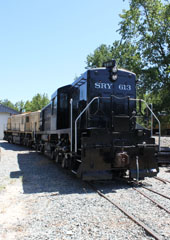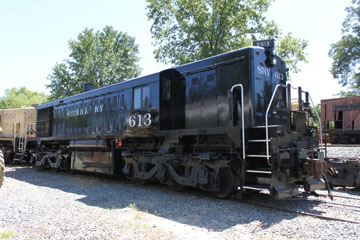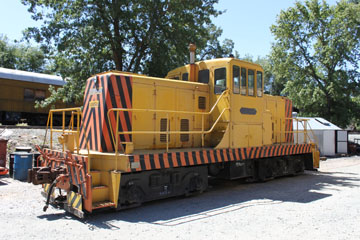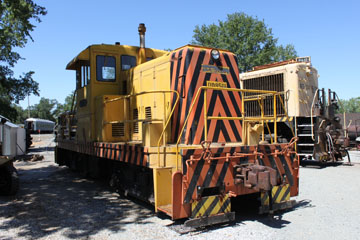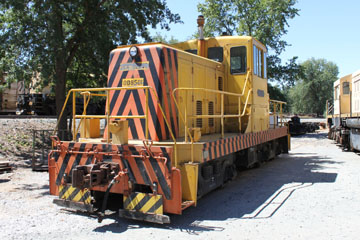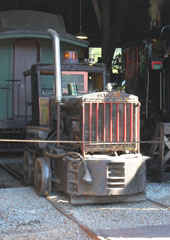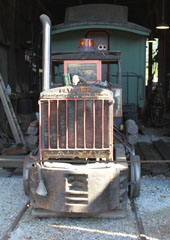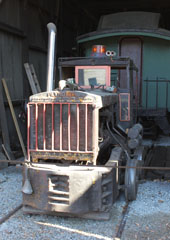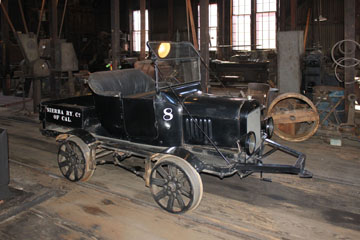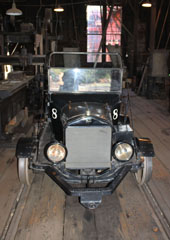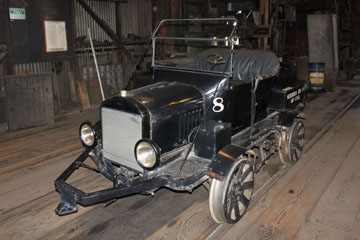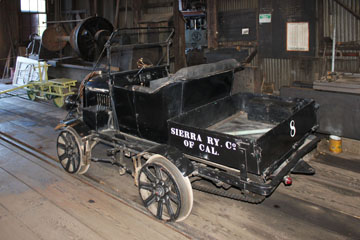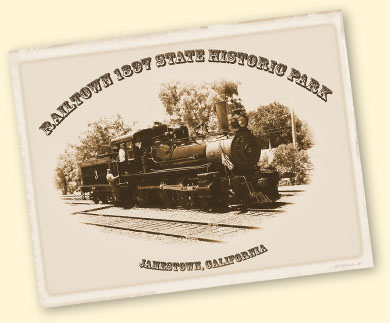

Railtown 1897 State Historic Park is located in Jamestown, CA. It preserves the historic core of the original Sierra Railway.
The Sierra Railway Company was incorporated on 1st February 1897. From a junction with the AT&SF and Southern Pacific at Oakdale, the line was pushed through Jamestown to Tuolumne City. In 1937, the railroad was sold to the newly formed Sierra Railroad Company. In 1955, the railroad dieselised, although the steam locomotives were retained for movie and television work. In 1971, “Railtown 1897” opened as a tourist attraction. In 1979, the Crocker Association, then owner of the railroad, closed Railtown and put both it and the Sierra Railroad up for sale. The railroad was bought by Silverfoot Inc., in 1980 and, two years later, Railtown 1897 was bought by California State Parks and reopened as Railtown 1897 State Historic Park.
The Sierra Railroad Corporation’s Mendocino Railway group still operates the Sierra Railroad Dinner Train out of Oakdale, the Woodland-Sacramento Sacramento RiverTrain and the Fort Bragg-Willits Skunk Train.

Left, the Jamestown depot building. Trains leave from the depot hourly from
11.00 am - 3.00 pm every weekend from April-October, with special holiday trains during November and December.
Middle photo left, the rear of the roundhouse. Docent-led tours of the roundhouse and work shop facilities are available hourly from 10.00 am - 3.00 pm Thursday through Monday.
Below, a panorama of the roundhouse, work shop facilities and turntable. These facilities still
function much as they
have done since 1897, although the manually operated turntable is a more recent addition, installed in 1922.

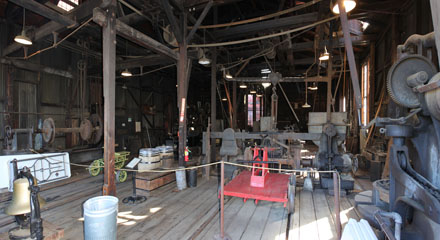
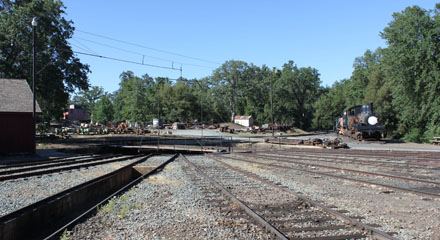
Top two views, inside the Machine Shop. Bottom view, looking across the turntable from the roundhouse.

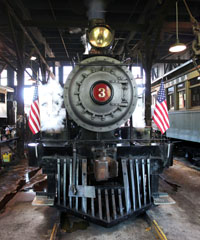
Sierra Railway #3 was in the roundhouse getting up steam and being inspected by the crew when I arrived.
#3 is the oldest surviving locomotive built by the Rogers Locomotive Works, in Paterson, NJ, later part of Alco. It was built in 1891 as “W. N. Kelley” for the Prescott & Arizona Central. Completed in 1886, the seventy-three mile line ran from Prescott, AZ to a connection at Prescott Junction (now Seligman) with the Atlantic & Pacific, a subsidiary of the AT&SF.
Built rapidly on a small budget, the line struggled from the start. High rates, poor service and arrival of a second connecting railroad, the Santa Fe, Prescott & Phoenix in 1893 brought a quick demise: within two months the P&AC was bankrupt.
The owner of the Prescott & Arizona Central, Thomas S. Bullock, then sought other opportunities to employ his now unused railroad equipment, winding up in Stockton, CA, in 1896 surveying potential routes into the central Mother Lode region.
His next venture was the Sierra Railway of California.
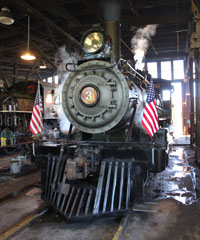
P&AC #3 became Sierra Railway #3, and apparently hauled the first passenger train to Cooperstown in June 1897, as well as helping to complete the line to Tuolumne in 1900.
It handled all freight trains until Consolidation type
(2-8-0) #18 arrived in 1906, when it became the primary relief engine while any of the three other locomotives were in the shops undergoing repairs.
Over the years, #3 was involved in several accidents. In February
1898, it derailed as a result of a switch mishap at Chinese, killing the conductor. In September 1899, its tender derailed while backing up on a trestle, and then, in early 1919, it was derailed again at Sanguinetti Road just above Sonora. The wreck crushed the side of the original wooden cab, which was replaced with a second-hand Central Pacific steel cab.
The Depression hit the Sierra Railway hard: in 1932, it went bankrupt and was reorganised as the Sierra Railroad in 1937. By then, #3 was out of service on a spur next to the turntable in Jamestown.
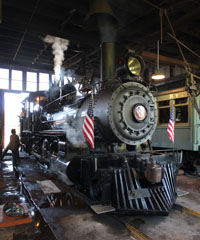
Above, #3 is ready to leave the roundhouse.
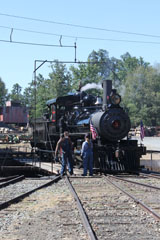
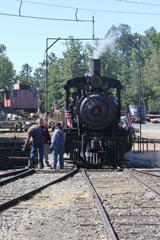
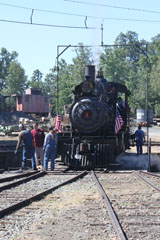
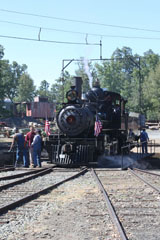
Above, turning #3.
After nearly ten years standing cold, in 1946,
the locomotive almost steamed for the last
time. The movie Duel in the Sun was being shot on the Sierra Railroad that year and, after restoring the engine to working order, the film-makers intended to use it in a spectacular
wreck scene at the end. Fortunately, Master Mechanic Bill Tremewan saw the future potential of the locomotive and decided to keep it in one piece. It went into the shops for a rebuild over the next two years, returning to work on 30th May 1948 hauling a Memorial Day special excursion for the Railway & Locomotive Historical Society.
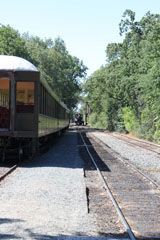
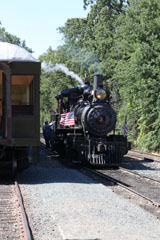
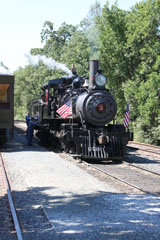
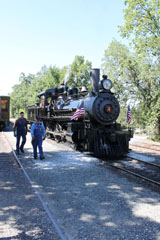
Above, after taking on water, #3 steams into the depot.
Now known as “the movie star” locomotive, #3 has appeared in more movies, documentaries, and television shows than any other engine. Its first movie after the 1946-48 rebuild was 1950’s Sierra Passage, starring Wayne Morris and Lola Albright, but it had appeared as early as 1919 in The Red Glove, a silent film serial starring Marie Walcamp and Pat O’Malley. The following year it featured in The Terror, starring Tom Mix, in the first talkie filmed on location, The Virginian, starring Gary Cooper and Walter Huston in 1929, and then, in 1930, in The Texan, starring Fay Wray.
#3 weighs 100,000 lbs, 80,000 lbs on its 56” drivers. With 17” x 24” cylinders, it was built to operate at 160 psi, delivering 17,470 lbs tractive effort, but a boiler check during the 1946-48 rebuild reduced this to 150 psi. The engine was taken out of service in 1996 and did not return until a major overhaul had been completed in 2010, including replacing the boiler.
#3 originally had a box oil headlamp and diamond stack but it has been restored to how it looked after the accident in 1918, with a round headlamp and cylinder funnel.
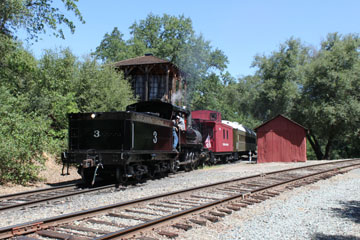
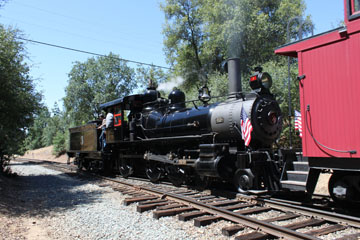
Above, reversing past the old water tower at the south end of the yard. The tower is probably best known for appearing in the opening sequence of every episode of the 1963-1970 television series Petticoat Junction. #3 was refitted with a diamond stack and square headlamp for the series, and renamed the "Hooterville Cannonball".
#3 has appeared in close to forty films, over thirty television series and TV movies, as well as numerous television advertisements. The depot, yard and roundhouse have also been the setting for a number of other movies, television programmes and advertisements. These include products as diverse as beer, chocolate, motorcycles, mashed potatoes and cough drops!
Left to right from the top, Sierra Railroad #3 in some of its many movie roles.
Top row: on the lower right playbill for The Terror (1920) directed by William Fox and starring Tom Mix; in The Virginian (1929) directed by Victor Fleming with Gary Cooper and Walter Huston, the first talkie filmed on location rather than on a studio sound stage; High Noon (1951) directed by Fred Zinnemann, starring Gary Cooper and Grace Kelly, and winner of four Academy Awards including Best Actor for Gary Cooper; The Cimarron Kid (1952) directed by Budd Boetticher and starring Audie Murphy and James Best.
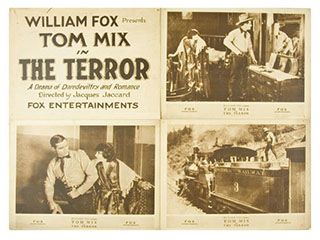
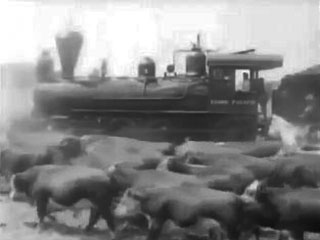
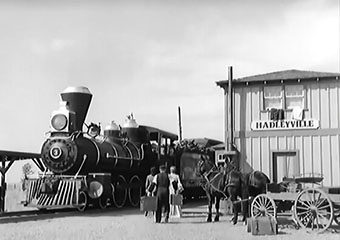
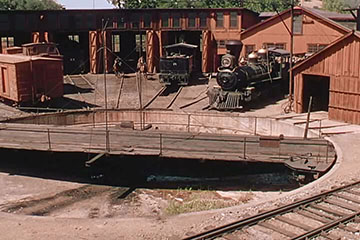
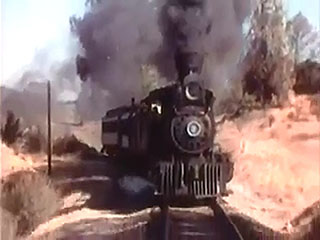
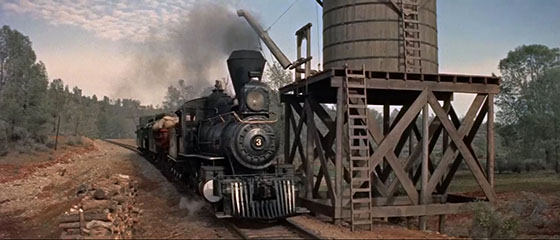
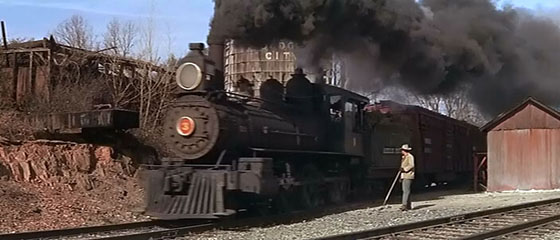
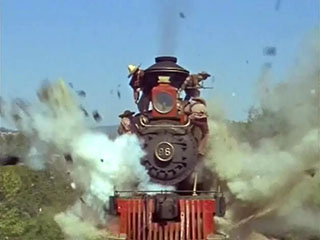
Middle row above, left to right, Rage at Dawn (1955) by RKO Pictures, directed by Tim Whelan and starring Randolph Scott and Forrest Tucker; Man of the West (1958) directed by Anthony Mann and starring Gary Cooper, Julie London and Lee J. Cobb; The Rare Breed (1966) directed by Andrew V. McLaglen with James Stewart, Maureen O'Hara and Brian Keith; and The Great Bank Robbery (1969) starring Zero Mostel and Kim Novak, in which #3 appears to suffer a boiler explosion.
Bottom row, left to right, in the comedy caper The Apple Dumpling Gang Rides Again (1979) starring Tim Conway and Don Knotts; next, kitted out as Rock Island Railroad #3 for The Long Riders (1980) directed by Walter Hill and starring three sets of brothers, James Keach and Stacy Keach, David Carradine and Keith Carradine, and Dennis Quaid and Randy Quaid (#3 also doubled as Missouri Pacific Railroad #43 in this film); and Back to the Future III (1990) directed by Robert Zemeckis and starring Michael J. Fox, Christopher Lloyd and Mary Steenburgen.
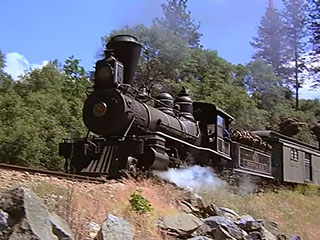
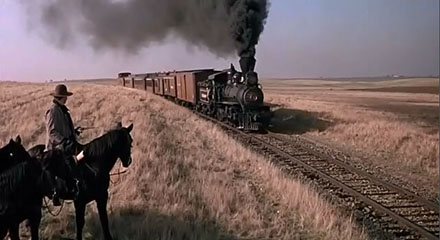
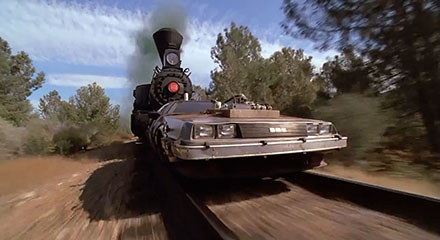
Left to right from the top, Sierra Railroad #3 in some of its television roles.
In the 1957 Tales of Wells Fargo episode "Belle Star"; as Midwest and Central Railroad #3 in the 1957-58 series Casey Jones; alongside the water tower shown earlier on this page in one of the early episodes of Petticoat Junction; in the 1964 pilot episode of The Wild Wild West, "The Night of the Inferno"; and in "The Runaway Caboose", a 1976 episode of Little House on the Prairie.
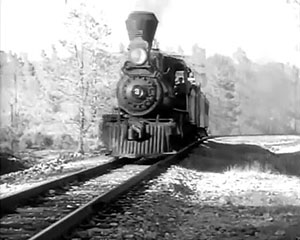
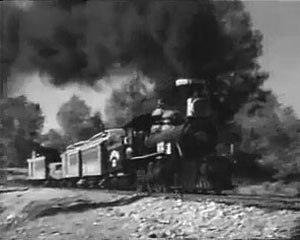
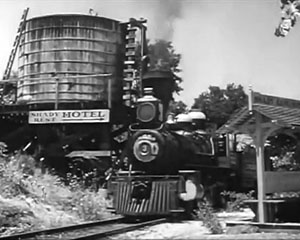
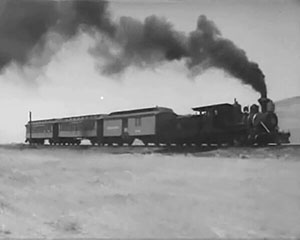
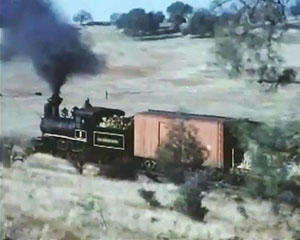

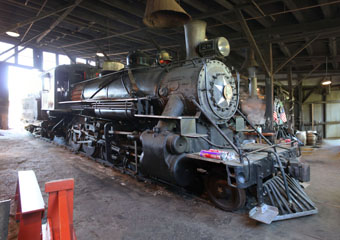
Back in the roundhouse, this Consolidation type (2-8-0) locomotive was built by Baldwin in 1922 for the Sierra Railway. It was ordered to haul heavy freight and, in the 1930s, also transported materials to the Hetch Hetchy dam site (for more on the Hetch Hetchy, see the next entry on this page for SERY #34).
After completion of the project, #28 returned to hauling freight. After dieselisation in 1955, it went into storage with #3, #34 and #36 at the Jamestown roundhouse, occasionally steamed up for filming and excursions. It was derailed on an excursion in 1963 and retired with damaged air brakes. Repaired by 1971 for the opening of Railtown 1897, it then regularly pulled the "Motherlode Cannonball" excursion from Jamestown to Fassler. It also appeared in several movies, including Bound for Glory (1976), Chattanooga Choo Choo (1984) and Bonanza, the Return (1999). That year, it also moved to Old Sacramento to participate in Raifair ’99.
Weighing 127,600 lbs, 142,000 lbs on its 48” drivers, #28 has 19” x 26” cylinders. With a 28.2 sq ft grate, 133 sq ft firebox and total heating surface of 1,901 sq ft, including 332 sq ft superheating, it operated at 180 psi delivering 29,918 lbs tractive effort.

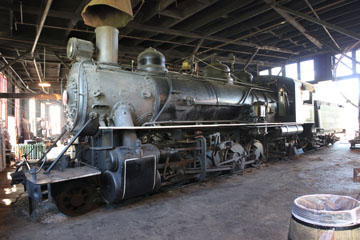
#34 is a Mikado type (2-8-2) locomotive built for the Sierra Railway in 1925 by Baldwin. It worked on the Melones Dam on the Stanislaus River and then, in 1935, on the Hetch Hetchy Railroad.
The Hetch Hetchy project in the Sierra Nevada Mountains of Yosemite Park was huge. Intended to meet the water needs of San Francisco, as well as dams, it involved conduits, powerhouses and a one hundred and fifty mile aqueduct. Machinery, equipment and thousands of workers had to be transported to remote sites, and the Hetch Hetchy Railroad, a sixty-eight mile line was built from the edge of the Hetch Hetchy Valley and the O’Shaughnessy dam site to the Sierra Railway at Hetch Hetchy Junction. After completion of the project, #34 returned to hauling freight. It too was retired in 1955 and spent much of its time in storage at Jamestown. It was sold to Reed Hatch in 1965 along with #36 for $1,500, but stayed at Jamestown and was leased back to Railtown to run excursions until 1980.
At 174,000 lbs, 140,000 lbs on its 46” drivers, #34 is the heaviest locomotive rostered by the Sierra. With 19” x 26” cylinders a 37.7 sq ft grate, 150 sq ft firebox and total heating surface of 2,684 sq ft, including 489 sq ft superheating, it operated at a boiler pressure of 190 psi delivering 32,953 lbs tractive effort.

#2 is an example of a Pacific Coast Shay.
These were more powerful versions of standard three truck Shays: #2 is superheated, has a 13” longer firebox, lower gear ratio, steel cab and cast steel trucks and is mounted on a steel girder frame.
A three truck Shay, #2 was built by Lima in 1922 for the Hutchinson Lumber Co., in Oroville, CA.
Following bankruptcy in 1927, Hutchinson Lumber was
reorganised as Feather River Pine Mills. Then, in 1940, the company’s logging railroad was incorporated as the common carrier Feather River Railway. The operation, including the railroad, was sold to Georgia-Pacific in 1955.
When the Feather River dieselised, #2, along with two other Shays, #1 & #3, became standby power. In 1964, the Pacific Railroad Association chartered the #2 & #3 for a final railfan excursion down the eighteen mile line from the Feather Falls mill to the Western Pacific mainline and then back up the 5½% grade to the mill. The railway was abandoned in 1967 after flooding of a portion of its line by Oroville Dam, and #2 was donated to the State of California. In 1976, it moved to Railtown, where it continues to operate hauling excursions.
The locomotive weighs 205,600 lbs. An oil burner operating at a boiler pressure of 200 psi, it delivers 40,400 lbs tractive effort.
Shay locomotives are geared on the right side of the engine.
Power is then transmitted from the cylinder rods by a drive shaft running the
length of the three trucks. Left, drive is transferred to the 36” wheels by bevelled gears.

Back out in the yard, this three truck Shay was built by Lima in 1925 as #5 for the Fruit Growers Supply Co., in Hilt, CA. In 1939, it was sold to the Standard Lumber Co., in Cochran, OR, and renumbered #80 and then, in 1947, it became Pickering Lumber #7 and was in Standard, CA. In 1968, it was sold to Glen Bell’s West Side & Cherry Valley Railroad, a tourist line operating over ex-West Side Lumber trackage.
#7 weighs 196,000 lbs. An oil burner with 36” drivers and 13½” x 15” cylinders, it operated at 200 psi delivering 35,100 lbs tractive effort.

Road Switcher (“RS”), 4th military type (“4”), Army Transportation Corps (“TC”) #1265 was built in 1953, one of sixty-six of this type built for the US Army between 1953 and 1955 (#1247-#1273 & #4001-#4039). Originally liveried in Army red, it has been painted black and silver and lettered for the Sierra Railway.
The 1200 series were built for domestic use, while the 4000s were for foreign service with adjustable trucks, axles and wheels. You can see two of the 4000 series, #4010 & #4044 on the Kentucky Railway Museum page of this website.
#1265 was rebuilt at Hill Air Force Base, and may also have been re-engined at Construction and Mining Services in St Louis, MO, with a Caterpillar model 3508 prime mover.
Weighing 60,000 lbs and 39’ 2” long, it has a Westinghouse WH1604C generator.
There are four Westinghouse 4WH974A traction motors, one on each axle of the General Steel Castings trucks, each with a 6’ 11” wheelbase.
Are these Whitcomb, Baldwin or Davenport units? The Invitation to Bid on 29th December 1951 specified that the Davenport DE-48 USAX 4000 was to be the basis for the design, but Baldwin had trouble getting plans from Davenport and only started the re-design process in June 1952. Although the units carried Whitcomb serial numbers, by then, Whitcomb’s Rochelle shops had closed. The bid also came from Baldwin’s Eddystone plant, where the units were built. So, technically, they are a Baldwin modification of a Davenport design and not a Whitcomb.

The mothballed units sat at the Transportation Corps Depot for nearly twenty years. Finally, in 1970, the Pentagon concluded that such a large-scale land war for which they had been designed was no longer likely. Many of the units were then assigned to various military installations around the country.
The Army decided to transfer its units to the US Navy, where #2091 was renumbered #65-00546.
Alco built this MRS-1 for the US Army in 1953 as #2091. Thirteen units were built in 1952 by both GE/Alco and EMD to the same specification for the US Army Corps. After testing, seventy more were ordered between 1953 and 1954, all built by Alco. As delivered, they were painted in gloss black with white numbering and lettering.
The MRS-1 was designed with the prospect of another land war in Europe during the “hottest” years of the Cold War, so it was equipped with adjustable trucks to fit different railroad gauges, compact bodywork for restrictive rights of way and replaceable couplers. But the war never eventuated, and the MRS-1s went into storage at the Transportation Corps Depot in Marietta, PA.

After disposal by the Navy, #65-00612 spent some time at the Western Railway Museum in Suisun City, CA. It then moved to the California State Railroad Museum, and finally wound up at its current home at Railtown.
A number of Alco MRS-1 units have been preserved. You can also see USA B-1809 on the Pacific Southwest Railway Museum page of this website, USA B-2069 on the National Museum of Transportation, St. Louis Yard page and USA B-2080 & USA B-2081 on the Nevada Northern Railway Museum page.
Another Alco MRS-1, this unit was built as USA B-2063 in 1953. It is one of fifty units equipped with a steam generator in the short hood for passenger service, their road numbers consequently prefixed with a ’B’ for boiler. At a cost of almost $500,000 each in 1952 dollars, more than three times the price of a standard locomotive of the period, the MRS-1s were certainly expensive locomotives.
After being transferred to the US Navy, B-2063 was renumbered #65-00612, and it was one of the five last Alco units in official service stationed at the Concord, California Naval Base. The others were #65-00613 (shown next on this page), #65-00614, #65-00616 and #65-00617.

This MRS-1 was built for the US Army as
B-2058 in 1953 by Alco. It was renumbered
#65-00613 when transferred to the US Navy. One of the last five in official service. It was bought by Railtown in 1991. Now
liveried as Sierra Railway #613, it is operational.
The 240,000 lb unit is 55’ 11” long, with an Alco 244D prime mover powering a GE-581 generator to drive four GE 752 traction motors. It has starting tractive effort of 40,000 lbs at 25% and delivers 30,700 lb continuous tractive effort at 11 mph with a top speed of 70 mph.
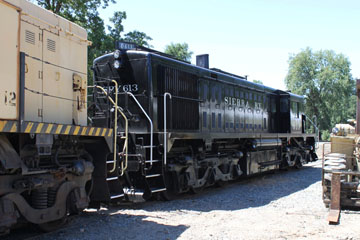
USA EMD MRS-1 #1820 is on the Pacific Southwest Railway Museum page of this website.

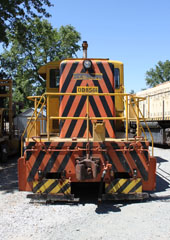
Still bearing its
Defense Supply
DLA-52280 livery, this 80-ton switcher was built by GE in 1952 for the US Army as #1638.
It worked at the San Jacinto Ordnance
Depot in Houston, TX, then the Sharpe Army Depot in Lathrop, CA, and the Tooele Army Depot in Tooele, UT, where it was rebuilt with a Cummins
turbo-charged 470 hp
6-cylinder engine. Declared surplus, it was bought in 1995 by Railtown from the Tracy Defense Supply Depot in Tracy, CA.
There are two ex-USA GE 80-ton switchers, #1601 & #8580, on the Orange Empire Railway Museum page of this website.

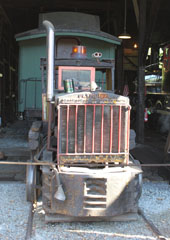
The Plymouth Locomotive Works, in Plymouth, OH, built this 8 ton switcher some time in the 1930s. It was bought by the Sierra Railway in the 1940s and re-engined in the 1970s with a Chrysler automotive motor.
Over 7,500 engines were built in Plymouth from 1910 under the J. D. Fate Company, then in 1919 as Fate-Root-Heath and only becoming Plymouth Locomotive Works in the late 1950s. They were generally under 25 ton gasoline burners designed for industrial use. The last engine came off the factory line in 1999.
You can see another 8-ton Plymouth on the Colorado Railroad Museum page of this website.

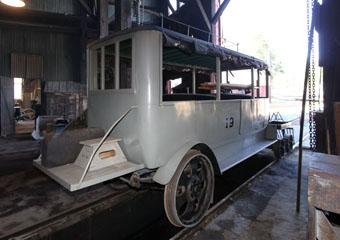
In 1919, the Hetch Hetchy Railroad ordered a car built on a White Motor Company standard truck chassis from A. Meister & Sons of Sacramento, CA. In 1920, the front truck and rail brakes were installed and a self-contained turntable added under the floor by the San Francisco Municipal Railway.
The first “track bus”, #19 could carry thirteen passengers, but was primarily used as an ambulance car during construction of the O’Shaughnessy dam carrying injured and dead to the hospital in Groveland, CA.
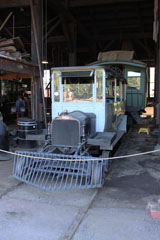
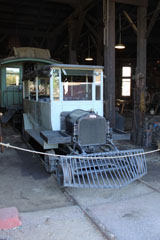
With its self-contained turntable it could be jacked up and turned anywhere along the line.
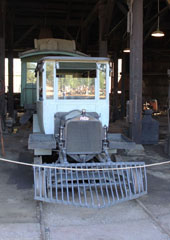
#19 was originally painted red and black, with gold lettering and ornamental tassels. It could run at speeds up to 50 mph and was so successful that five more were ordered in the ensuing years.
After retiring, #19 was saved from scrapping by Modesto resident and railfan, Al Rose, who bought the car. It was restored to operating condition by the White Motor Co., just before it was placed in the El Portal, CA,Transportation Museum.
After many years at the museum, Al reclaimed #19 and returned it to storage. In July 1997, Helga Rose, Al’s
widow, donated it to Railtown.

Sierra Railway #8 is another modified gasoline powered rail car.
It was assembled by the Sierra Railway from a 1920s Model T Ford body and engine, and was equipped with running gear from a Fairbanks-Morse speeder.
Although somewhat exposed to the
elements (there
appears to be no canopy), this is a step up in terms of comfort compared to the hand cars shown next on this page.
#8 was probably used by more senior crew, such as foremen.
The Model T was such a common part of life in the teens and twenties that it was adapted to all sorts of different uses.

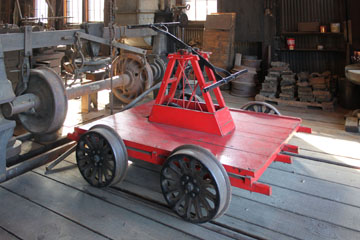
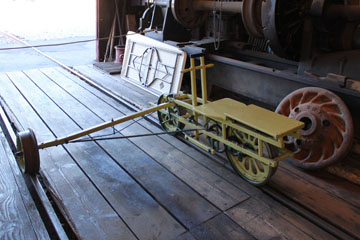
Above, a couple of old hand cars in the machine shop. Originally the engine house, after a four stall roundhouse was built in 1900, it became the machine shop. The old roundhouse burned down in 1910, but the shop survived. The roundhouse was extended to its current six stalls in 1922, at which time the nearby motor-car garage was also constructed.
Hardly glamorous by rail fan standards, hand pumped handcars like these were nevertheless an important part of railroad operations. They were used by track inspectors and railroad work crews to move quickly to and from work sites with their tools, and could be easily lifted clear of the tracks to allow regular trains to pass.


